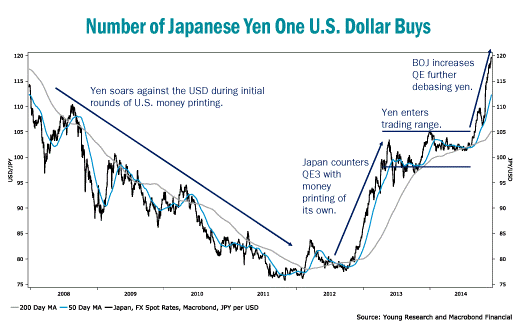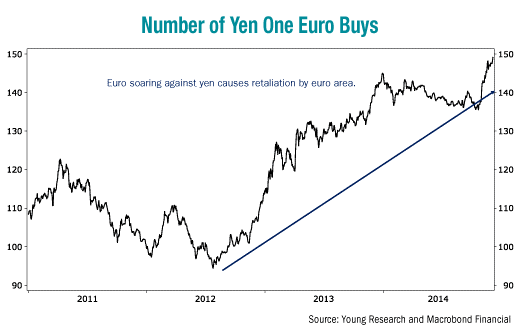This is an excerpt from Young Research’s Global Investment Strategy (December 2014 issue), where we help investors compound wealth with investment strategies that span the global investment landscape. We cover the global stock and bond markets as well as currencies and commodities. Young Research’s Global Investment Strategy is designed for the investor who does not want his investment success bound by the opportunities of a single market.
The currency wars that the world’s major economic powers are engaged in are not being fought with the same tactics as previous currency wars. There are no tariffs or duties being slapped on foreign produced goods, and you will hear no official policy of currency devaluation from government officials. But don’t let that fool you.
The world’s major economic powers are indeed engaged in currency wars. The weapons on today’s battlefield are just monetary in nature rather than regulatory. Zero percent interest rates, forward guidance, and—the most powerful of all—quantitative easing are the artillery on today’s battlefield.
An Escalation
Over recent months, the currency wars have escalated greatly and the implications for the global economic and financial system, as well as your portfolio, are profound.
U.S. Fired First Shots
The start of the latest battle can be traced back to the fall of 2012, when the Fed started its third round of quantitative easing. QE3 was sold as a way to accelerate U.S. growth, but one of the ways it was supposed to achieve faster growth was to hold down the value of the dollar. The problem with such policies is that when one country debases its currency, it is often at the expense of another country.
Which country suffered most from the Fed’s prior rounds of money printing?
That would be Japan. From the fall of 2008 to the fall of 2012, the yen appreciated 25% against the USD, impairing Japan’s competitive position and reinforcing unwanted deflationary forces in the country.
Japan Retaliates
So what did Japan do? They responded to the Fed’s QE3 program with a money printing program of their own. When scaled by the size of each economy, Japan’s money printing campaign was orders of magnitude larger than the U.S. program. Japan’s QE program was a success at blunting the currency impact of the Fed’s QE3 program. From the time it became clear the Bank of Japan was preparing to undertake a quantitative easing program in the fall of 2012 until the spring of 2013, the yen lost a quarter of its value versus the dollar. The yen then entered a 16-month trading range that ended early this fall.
What caused the yen to break out of this trading range? Investors began anticipating a higher level of money printing from the BOJ. When the BOJ confirmed investors’ suspicions on October 31, the very same day the Fed ended its own QE program, the devaluation of the yen went into overdrive. Since the announcement the yen has fallen 10%. See chart.
Euro Area Enters the Battle
One of the consequences of the plunging yen has been a soaring euro vis-à-vis the yen (see chart). With growth in the euro area stagnating and deflation on the euro area’s doorstep, a strengthening currency has been a headwind for the euro area economy. The strong euro has hurt the competitiveness of the euro area’s exporters and has held back growth.
QE coming to Euro-land
So how has the euro area responded? How else? You can’t bring a knife to a gun fight and expect to win, so the European Central bank countered Japan’s ramped up QE program with the threat of a money printing campaign of its own. In November, ECB President Mario Draghi signaled that a full-blown QE program (in addition to measures already announced) is probable, despite objections from Germany.
Draghi’s aim does not seem to be targeted at lowering euro-area government bond yields, as most QE programs profess to do. Euro-area government bond yields are already trading at historic lows. Draghi’s goal is to devalue the euro.
In a speech last month explaining the rationale for a quantitative easing program from the ECB, Draghi said the following:
“Substitution of assets can also take place across jurisdictions, which would take the form of investors rebalancing portfolios away from euro-denominated assets towards other jurisdictions and currencies providing higher yields.
For example, there is evidence that both the various Large Scale Asset Purchase programmes of the Fed as well as the Bank of Japan’s Quantitative and Qualitative Easing programme led to asignificant depreciation of their respective exchange rates, even in a situation in which long-term yields were already very low, as in Japan.”
You aren’t going to get a more explicit signal on a desired currency move from a central banker than that. Draghi is planning to retaliate against the Japanese devaluation with a devaluation of his own.


